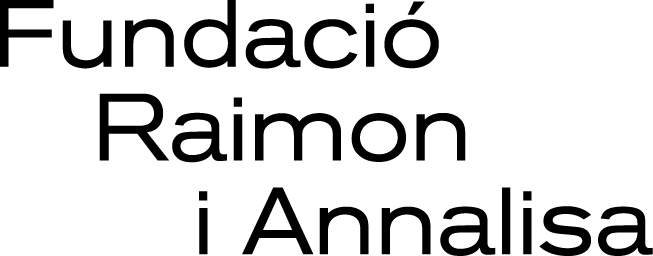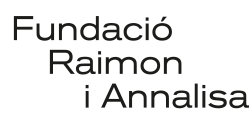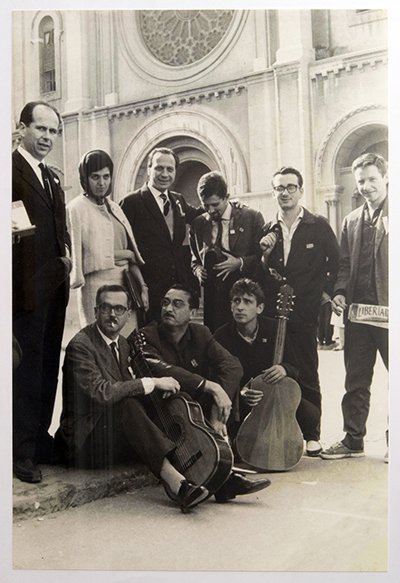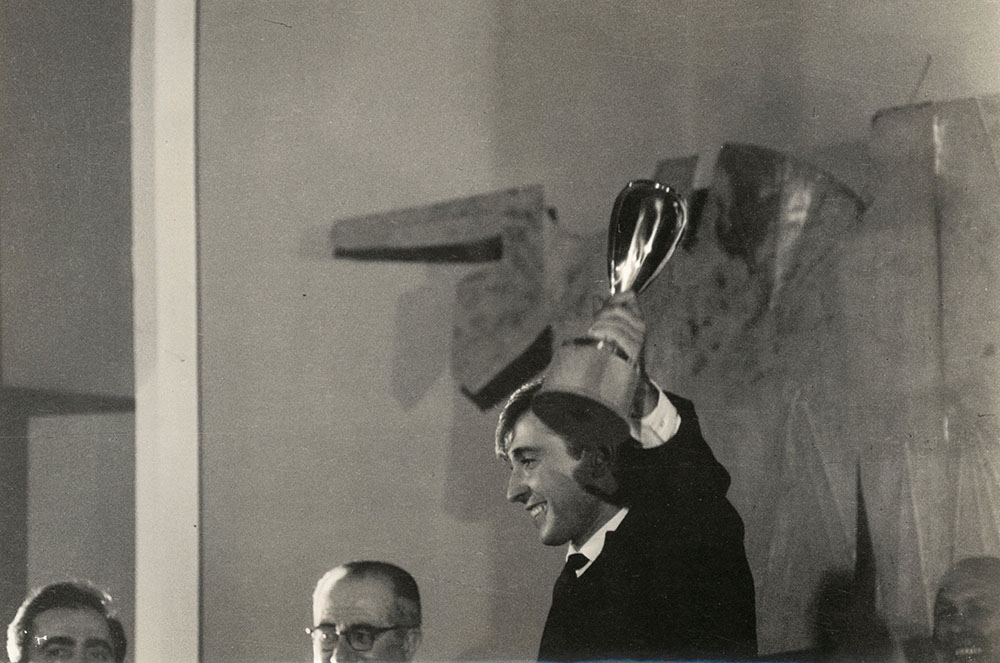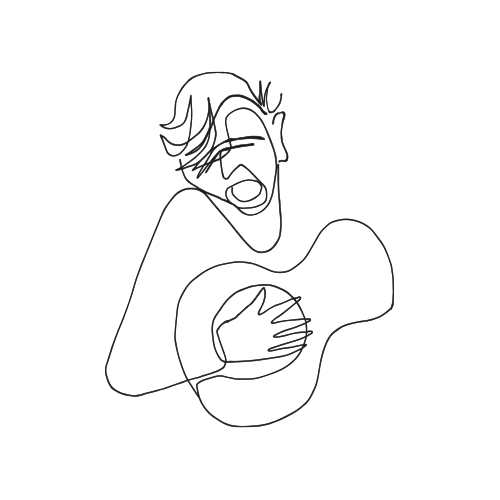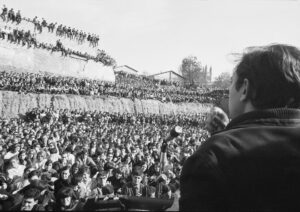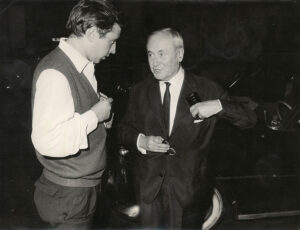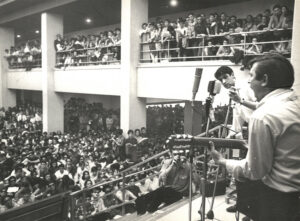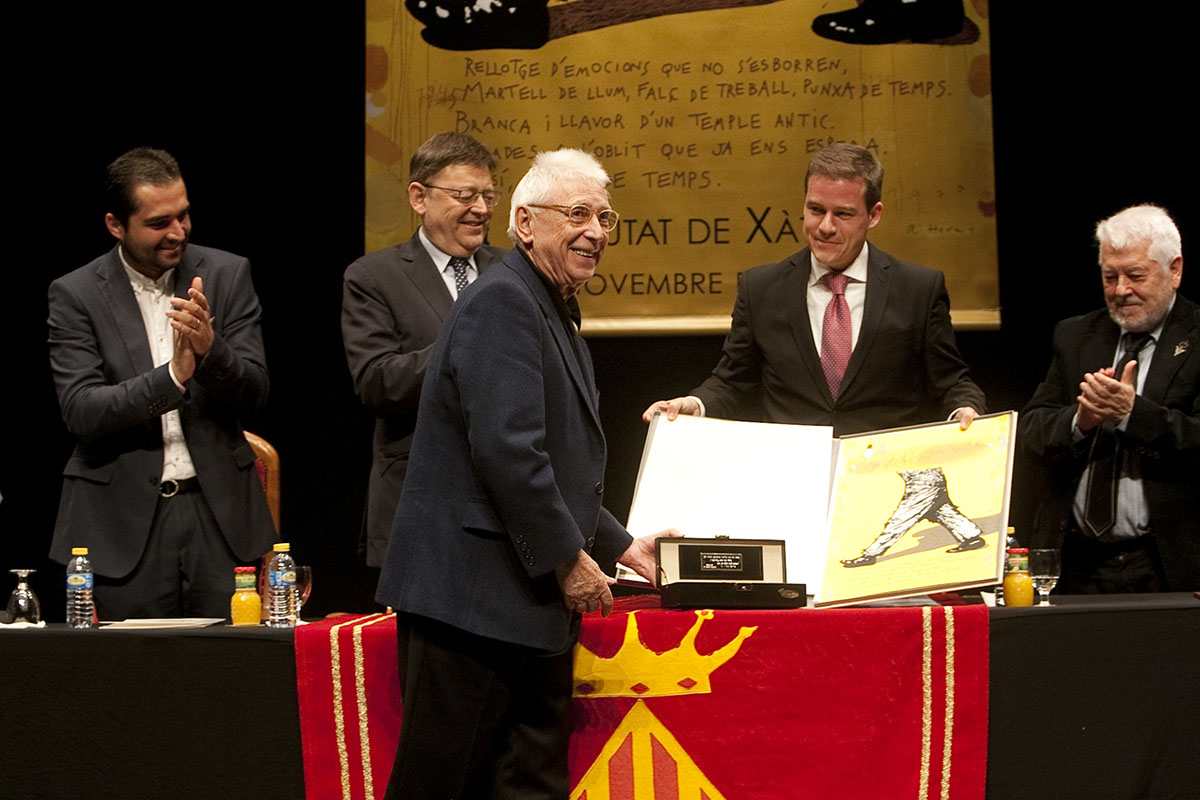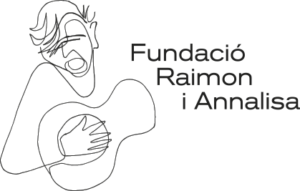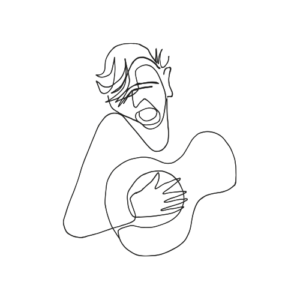Summarised Biography
Ramon Pelegero Sanchis, better known by his stage name Raimon (Xàtiva, 2nd December 1940), is one of the most representative and internationally recognised members of the contemporary history of song in Catalan.
Born on Blanc Street in Xàtiva -a place mentioned in some of his songs-, Raimon was already a member of the Música Nova band at the age of eight, playing the flute and piccolo. His Father was the president of the band and two of his brothers were also members. While completing his Baccalaureate studies as a young man, Raimon also worked for a couple of years at the local radio station in his town, where he was introduced to the world of records and became acquainted with such diverse artists as Juliette Gréco, The Platters, Juanito Valderrama, etc. He also took an interest in great classics such as Vivaldi, Bach, Mozart, Beethoven and Stravinski, listening to their discographies.
New York Times, Le Monde, The Guardian, Frankfurter Allgemeine Zeitung, Le Nouvel Observateur and l’Espresso, among others, have all praised his work.
“Literature written in our own language was completely unknown to us. There was no Catalan literature, no songs, no artistic productions of any kind from our own culture. What a time!”
— Raimon, Les hores guanyades (Ediciones 62, 1983)
Download the full timeline.
1970 | 1979
The bans and arbitrary nature of censorship continued and Raimon was prevented from singing at the Teatre Romea in Barcelona in 1970, where he had scheduled six recitals for January.
In March he sang at the Faculty of Law in the University of Barcelona. He was banned from presenting Joan Brossa’s book Poesia Rasa at the Cinc d’Oros bookshop.
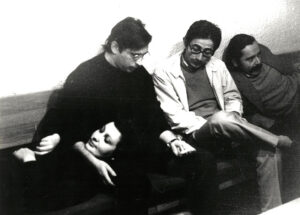
With Xavier Rubert de Ventós, Eugenio Trias and Annalisa at the Monastery of Montserrat against the Burgos Trial. December 1970. Photo: Colita.
Universities and the Church were not directly dependent on the governor of the province at the time and it was the dean or the bishop who decided whether or not to allow an event to be held.
Raimon travelled to the USA in April and met Pete Seeger on April 4th at the Hei Brother café in St. Gregory Church. Pete Seeger performed there and heard Raimon for the first time.
On the 7th, Raimon sang at the Folklore Center presented by Izzy Young, who had previously organised performances at the same venue with Bob Dylan and Joan Baez in their early days.
On April 18th, Raimon sang at Washington Square Church.
In May, he sang at Columbia University, at the New School Auditorium and again at Georgetown University in Washington.
He coincided with Pete Seeger again in May at St. Paul’s Church, and was subsequently invited to sing with him at Carnegie Hall.
In June, Raimon recorded an LP for Folkways Records with a cover song by Pete Seeger: Catalonian protest song.
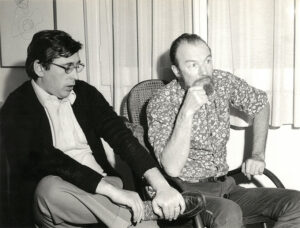
With Pete Seeger at Raimon’s house in Barcelona.
He returned to Barcelona in July.
Raimon performed at the Teatre Poliorama in Barcelona in November, presenting eight recitals over a seven-day period, with the first part of Pi de la Serra.
He concluded the year by taking part in an assembly of intellectuals held at the Montserrat monastery in protest against the six death sentences handed down to Basque militants at the historic War Council in Burgos. Raimon received police records, fines, bans and summonses as a result of his involvement in the assembly.
After releasing a new single that included Ausiàs March ’s first musical work, Veles e vents, Raimon released Per destruir aquell qui l’ha desert in 1970, an LP with arrangements by Lleó Borrell and a cover by Antoni Tàpies. The first side was entirely devoted to music by poets of 15th-century Catalan literature and contained the poem Desert d’amics (the original title, Presoner, was banned by censors) by Jordi de Sant Jordi; a fragment from Anselm Turmeda’s Llibre de bons amonestaments entitled Elogi dels diners, and four poems by Ausiàs March : Veles e vents, Així com cell qui es veu prop de la mort, Quins tan segurs consells and Si com lo taur. On side B, in addition to Espriu‘s Indesinenter, there are five songs with texts by Raimon himself: Societat de consum, Quan creus que ja s’acaba, De nit a casa, T’ho devia and Sobre la pau.
In May 1971, Raimon performed at the Teatro Eliseo in Rome, Italy, at the Premio Roma Festival; at the theatre of the University of Padua and in Venice at the Ca’ Foscari university theatre.
In August he was invited to perform in Argentina, Chile and Uruguay: he sang for seven days at the Teatro Payró in Buenos Aires and also in Rosario, Cordoba and Mar del Plata. He also performed at the Teatro Stella and in the University Auditorium in Montevideo, before visiting Chile to perform at the Teatro Marconi in Santiago and the Teatro IEM in the city of Concepción.
The tour ended at the Gran Rex in Buenos Aires with two recitals accompanied by Quilapayun, Los Olimareños and Mercedes Sosa.
Another LP was released, including 13 de març, cançó dels creients – a song composed following the very moving recital at the Price – and the love song Quan te’n vas.
The years 1970, 1971, 1972, 1973 and 1974 were particularly difficult in Raimon’s life. Numerous prohibitions were alternated with inexplicable concessions within a dictatorial logic. He was granted permission to sing in some towns in Girona, Mallorca and Tarragona, and refused in others not more than a few kilometres away. He performed eight recitals at the Teatre Romea in Barcelona in October 1973, but was refused permission to sing in Vallvidrera (Barcelona) the month before. He could sing in Mallorca (occasionally, not always) but was never given permission to sing in Menorca. Even less explicable is the case of Valencia. A number of recitals were banned from being held in Valencia in March and October 1971, and permission was granted for ten recitals in October 1973 at the Cine Quart 23 in the same city. During the same week in 1972, while bans were issued in Canals, Xàtiva, Alginet, València and Torrent, permission was granted in Alcoi.
Raimon alternated performances throughout the country with performances abroad.
He sang for the third time at the Olympia in Paris on March 3rd, 1974.
He then ended up in Mexico in 1974, where he sang at the Teatro Bellas Artes, at the University of Mexico city and in the city of Cuernavaca.
1973 saw the publication of Raimon’s book Poemes i cançons, with a prologue by Manuel Sacristán, a Marxist intellectual of recognised prestige, and a cover by Antoni Tapies. The presentation of the book, which was to be hosted by Joan Fuster in Valencia, was banned.
In the same year, 1973, Raimon released the album A Víctor Jara, with the collaboration of French avant-garde musicians conducted by Michel Portal. The album contained poems by Ausiàs March such as No em pren així, Lo jorn ha por; by Joan Roís de Corella: Si en lo mal temps; by Joan Timoneda: Só qui só and a very special lullaby by Pere Quart: Una vaca amb un vedellet en braços. Raimon’s original texts are: T’he conegut sempre igual, Molt lluny, Morir en aquesta vida, Amb tots els petits vicis and the love song Com un puny (written in deca syllables with a caesura on the fourth syllable in the manner of Ausiàs March and a consonant rhyme that is uncharacteristic of his style). The dedication to Víctor Jara, recently assassinated by the Pinochet dictatorship, was given further emphasis by the inclusion of Amanda, a Catalan version of Jara’s song Te recuerdo, Amanda. The presentation of the LP, scheduled to take place in Madrid on May 9th 1974, was banned.
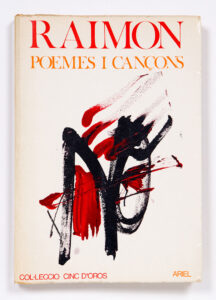
Cover of the book Poemas y canciones, Editorial Ariel, 1974. Barcelona. (With prologue by Manuel Sacristán). Cover by Antoni Tàpies. Photo: Federico Studio.
Again in 1973, Raimon released two more albums: one in France, T’adones, amic, with several songs that had been previously banned in the south of the Pyrenees. The other album, Campus de Bellaterra, was recorded live at a multitudinous recital held at the Universitat Autònoma de Barcelona and contained several songs that hadn’t been previously published in Spain due to their strong civic content: Qui ja ho ho sap tot, A un amic, 18 de maig a la Villa, No em mou el crit, Quan jo vaig nàixer and Espriuu’s poem dedicated to Pompeu Fabra, El meu poble i jo. The proceeds from that recital, organised by the PSUC university students, were put towards the university movement.
Raimon was allowed to sing at the Faculty of Medicine on June 18th, 1974.
He also returned to the Palau de la Música Catalana in Barcelona where he performed for eight days during the month of April 1975.
On October 30th, while Franco was on his deathbed, Raimon premiered Jo vinc d’un silenci at the Palau d’Esports in Barcelona. The proceeds of the recital were donated to the Catalonian Assembly, an organization devoted to fighting for democracy. The event was a great mobilising force at a time of uncertainty and lethargy.
In November of the same year, Raimon travelled to Sweden to take part in events organised to support Chile after Pinochet’s coup d’état. He sang solo on the 23rd at Clara Teatem in Stockholm and on the 25th in Uppsala at the House of Culture. With Isabel and Angel Parra in Stockholm and with Quilapayun in Gothenburg.
Again in support of Chile, Raimon performed at the Palais des Sports in Paris along with Serge Reggiani, Daniel Viglietti, Paco Ibáñez, Maxime Le Forestier, Colette Magny, Claude Vincy, Patricio Manns. The show was presented by J. L. Trintignant, who recited the text of the song Quatre rius de sang in French as a prelude to Raimon’s performance.
Raimon finished the year in Romania where he sang Bucharest at the House of Writers and the University of Bucharest.
In February 1976, he sang what was to be the first of four recitals at the Real Madrid Sports Pavilion, however the other three were banned by the minister Manuel Fraga Iribarne. The atmosphere of the concert is recorded on a double album, El recital de Madrid.
Following the dictator’s death, Raimon continued to experience difficulties performing right up to 1979. He was banned from performing at the Marcol Sports Pavilion in Valencia in March, and was prevented from singing at the Palau de la Música Catalana in Barcelona.
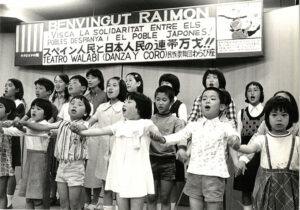
Warabi, Japón. Foto: Koji Yakamoto.
Canta en Dortmund (Alemania) y participa en un programa de la televisión Vara en Róterdam (Holanda).
El 9 de mayo canta en Madrid en el Festival Ibérico y el día 28 en la Facultad de Derecho de Barcelona. En julio, el día 3, canta en el campo de fútbol del Levante en València, el 11 en el Teatre Greg de Barcelona y el 24 participa en las Sis Hores de Cançó en Canet, la edición más multitudinaria con más de sesenta mil personas llenando el Pla d’en Sala: en uno de los momentos más emotivos de la noche, durante la actuación de Raimon, una grúa eleva una enorme senyera. Acaba el 1976 en Madrid, en diciembre, cantando una semana al Teatro Fígaro.
He sang in Dortmund (Germany) and took part in the Vara TV programme in Rotterdam (The Netherlands).
From 1977 onwards, Raimon spent a lot of effort to avoid becoming part of what he sarcastically termed the “Museum of Resistance ” towards which he was constantly being pushed. Although he gave four performances at the Palau d’Esports in Barcelona in February 1977, he increasingly avoided more and more mass recitals. He began to perform accompanied by the double bass player Enric Ponsa and before long had a whole band behind him; until then, Raimon had always performed solo on stage, with his guitar.
Raimon was awarded the Long Play de Oro in Madrid during the month of March.
In the same year, 1977, he released the album Lliurament del cant with arrangements by Michel Portal including poems by Timoneda (Bella, de vós so enamorós, Qui té anguila per la cua), Espriu (Potser arran de l’alba) and songs with his own lyrics: Qui pregunta ja respon, Un lleu tel d’humitat, Tristesa el nom, Com una mà (dedicated to the painter Viladecans), Que tothom, A Joan Miró – a song unpublished in Spain because of censorship – and a studio version of Jo vinc d’un silenci.
In May and June he toured Japan to perform 28 concerts.
May:
Utsunomiya, Tichigi, held at Hachimanyama park on the 15th.
Kioto, held in Hall 1 of Kyotokaikan on the 16th.
Tokyo, held at the metropolitan gymnasium of Tokyo on the 18th.
Hiroshima, held at the provincial gymnasium of Hiroshima on the 19th.
Wakayama, held at the Wakayama Culture & Arts Hall on the 20th.
Kanazawa, Ishikawa, held at the Ishikawa Industrial Exhibition Hall on the 22nd.
Otsu,Shiga, held at the Otsu Shimin Kaikan Civic Hall on the 24th.
Kobe, Hyogo, held at the Kobe Bunka Hall on the 25th.
Osaka, held at the Osaka Kouseinenkin Hall on the 26th.
Tokyo, held at the Arakawa Public Hall on the 28th and 29th.
Tokyo, held at the Kudan Kaikan Hall on the 30th.
June:
Tokyo, held at Yomiuri hall on the 1st.
Tokyo, held at Tachikawa Simin Kaikan on the 2nd
Chiba, held at Chiba Simin Kaikan on the 3rd
Kofu, Yamanashi, held at YCC Kenmin Hall on the 4th.
Shirakawa, Fukushima, held at Shirakawa Simin Kaikan on the 6th.
Nagoya, Aichi, held at Nagoya City Assembly Hall on the 7th.
Mito, Ibaraki, held at Shimin kaikan on the 8th.
Oodate, Akita, held at the local gymnasium on the 10th.
Tazawako, Akita, held at Warabi Theatre on the 11th.
Kumamoto, held at Shimin Kaikan on the 13th.
Fukuoka, held at Shimin Kaikan on the 14th.
Saga, held at Shimin Kaikan on the 15th.
Okayama, held at Shimin Kaikan on the 17th.
Hakodate, Hokkaido, held at Shimin Kaikan on the 20th.
Sapporo, Hokkaido, held at Kyosai Hall on the 21st.
Yokohama, Kanagawa, held at Shimin Hall on the 22nd.
Before the tour, Ongaku Center published a Raimon LP with texts in Catalan and Japanese and a cover by Joan Miró.
Raimon performed at the Teatre Talia in Valencia for seventeen days in October and the Grand Amphitheatre of Sorbonne University in November. The proceeds of a recital held in Sant Andreu (Barcelona) were confiscated by the police in December. The reason? The proceeds were going to be donated in full to Comisiones Obreras, the Spanish communist trade union federation. On the 19th of the same month, Raimon performed at the Palau de la Música Catalana in Barcelona under the title “Raimon per la llibertat d’expressió: Salvem el Brusi” (Raimon for freedom of expression: Save the Brusi).
Suisse Romande TV producer Richard Dindo attended a number of Raimon’s recitals in 1977 and, as a result, produced the film entitled Raimon. Chansons contre la peur broadcasted by Suisse Romande television.
Raimon toured all over Spain throughout 1978 and 1979 and made very few trips abroad; one to Belgium to record a programme for Belgian television and another to Berlin to perform at the Auditorium of the Technical University. He also visited Paris to sing at the Fête de l’Humanité and Bourges where he sang on April 13th 1979 at the Gran Théatre de la Maison de Culture, at the Printemps de Bourges festival.
A new album was released with a cover by Joan Miró, which Raimon presented with seven recitals at the Palau de la Música Catalana in Barcelona: Quan l’aigua es queixa, with arrangements by Manel Camp, including poems by Espriu: Nous cants de llibertat and I beg your pardon, and by Ausiàs March : Si em demanau and On és lo lloc, and songs with his own lyrics: Als matins a ciutat, L’última llum, Un sol consell, No el coneixia de res, Fou un infant, Perquè ningú no em contarà els seus somnis, I després de creure tant i Andreu, amic, dedicated to the sculptor Andreu Alfaro. The release of these songs consolidated Raimon’s poetic and musical maturity, while at the same time allowing him to flee from the reductionism that many tried to use to discredit and corner him. It was clear that Raimon’s art was not ephemeral and his songs were futuristic thanks to their combination of ethics and aesthetics.
1980 | 1989
Raimon sang at the Teatro Alcalá in Madrid from the 5th-7th March 1980, then on the 8th in Salamanca and on the 9th in Valladolid. He then returned to Valencia to sing at the Teatre Principal on the 11th, 12th and 13th April. He took part in the International Poetry Festival held at Rotterdam in June before travelling to Barcelona to perform at the Teatre Greg on July 14th, 15th and 16th, and on the 11th October at the auditorium of the University of Barcelona where the ceremony was held to appoint Salvador Espriu as doctor honoris causa. He performed Les cançons de la roda del temps accompanied by double bass players Xavier Cubedo and Mario Valero.
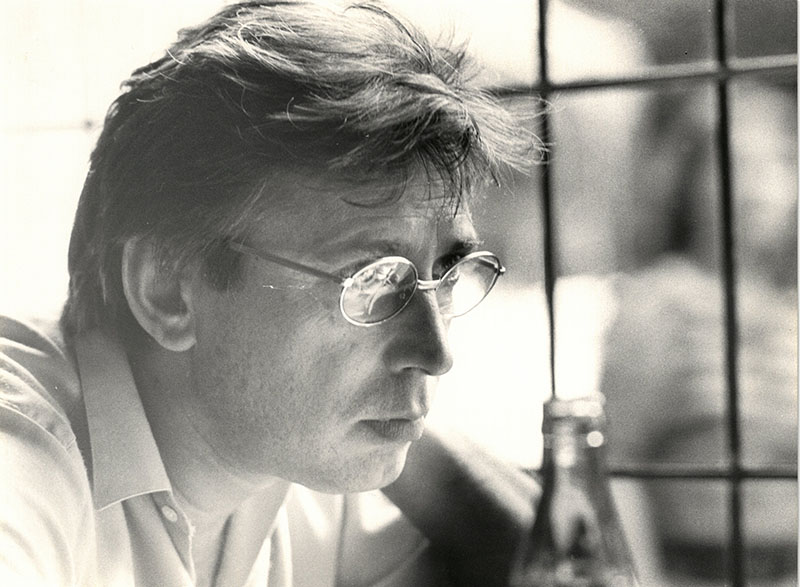
Raimon in Barcelona, 1981. Photo: author unknown.
Now free of the dictatorship and censure, Raimon decided to put his work in order and re-recorded all his songs in 1981 with new arrangements by Manel Camp and Antoni ros-Marbà, resulting in a set of ten disks grouped by themes: Orígens, Cançons d’amor, Ausiàs March , Dedicatòries, Cançons de la roda del temps (Espriu), He mirat aquesta terra (Espriu), Poetes dels segles XV i XVI, Amb els nostres silencis i les nostres paraules and L’aigua del temps que vius. The tenth disk (Testimonis) is comprised of live recordings and includes a version of Al vent sung in Japanese by the Japanese Warabi-za choir.The unreleased songs contained in Raimon. Totes les cançons (City of Barcelona Prize) include superb musical compositions by Roís de Corella, Timoneda, Ausias March and Espriu.
The ten-LP box set is a compilation of all the songs composed up to that time and contains a booklet with studies by Joan Fuster, Enric Gispert and Salvador Espriu on Raimon’s work. During the recording, Raimon wrote a diary with interesting thoughts on the political climate – the attempted coup d’état of February 23rd 1981 surprised him in the middle of the recording -, his artistic work and many other reflections. Edicions 62 published his diary in 1983 under the title Les hores guanyades. In 2012, Plataforma Editorial published Les hores guanyades under the title La vida immediata with the original Catalan text and La vida inmediata in Spanish.
Raimon presented “Els nostres clàssics” at the Teatre Principal in Valencia from 14th-16th May 1982 and at the Teatre Poliorama in Barcelona from 8th-12th May.
He travelled to Paris in 1983 to film the programme Tal com són, for the Catalan TVE channel, and then went on to New York where he performed in the auditorium of the New York University, presented by Pete Seeger.
He sang in Jardín dels Vivers, Valencia, in July and in the Auditorium of Palma in August, before performing a moving recital at Plaza de la Galera in Xàtiva, near to his house on Blanc street. He sang at the Theater am Turm in Frankfurt, Germany from 22nd-26th October.
February 1st 1984 saw the filming of the Raimon Special at the Teatro de Bellas Artes, Madrid. This programme, scripted by Manuel Vázquez Montalbán and directed by Alfonso Ungría, was broadcasted in June 1984 and was Raimon’s only appearance on TVE throughout Spain since 1964.
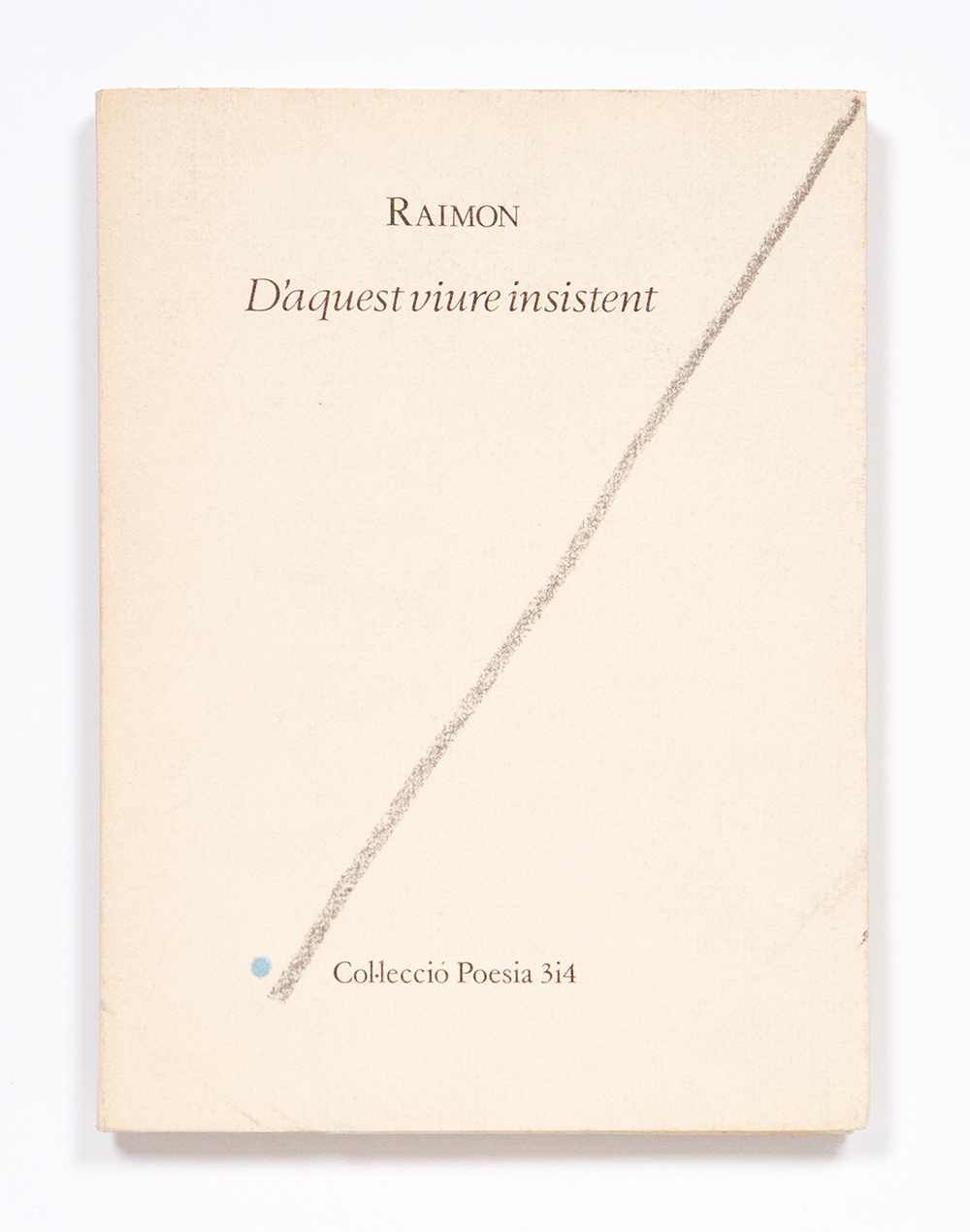
Portada de Andreu Alfaro para el libro D’aquest viure insistent, Editorial 3 y 4, 1986, Valencia.
Raimon toured the Valencian region for the first time during the months of March and April: Elx, Alacant, Gandia, Alcoi, Alzira, Valencia and Sueca.
Raimon sang in New York at the Casa de España and in Washington at the North American Catalan Society.
He made a second tour of the Valencian Region organised by the Generalitat Valenciana during the months of March, April and May 1985: Xàtiva, Tavernes de la Valldigna, l’Alcúdia, Dénia, Novelda, Cullera, Alcant, Algemesí, Manises, la Vila Joiosa, Ontinyent, Betxí, Castelló, València, Ibi and Vila-real.
He sang again in the Basque Country and Valencia during 1986, then began to prepare the album Presències i oblit, which was released in 1987.
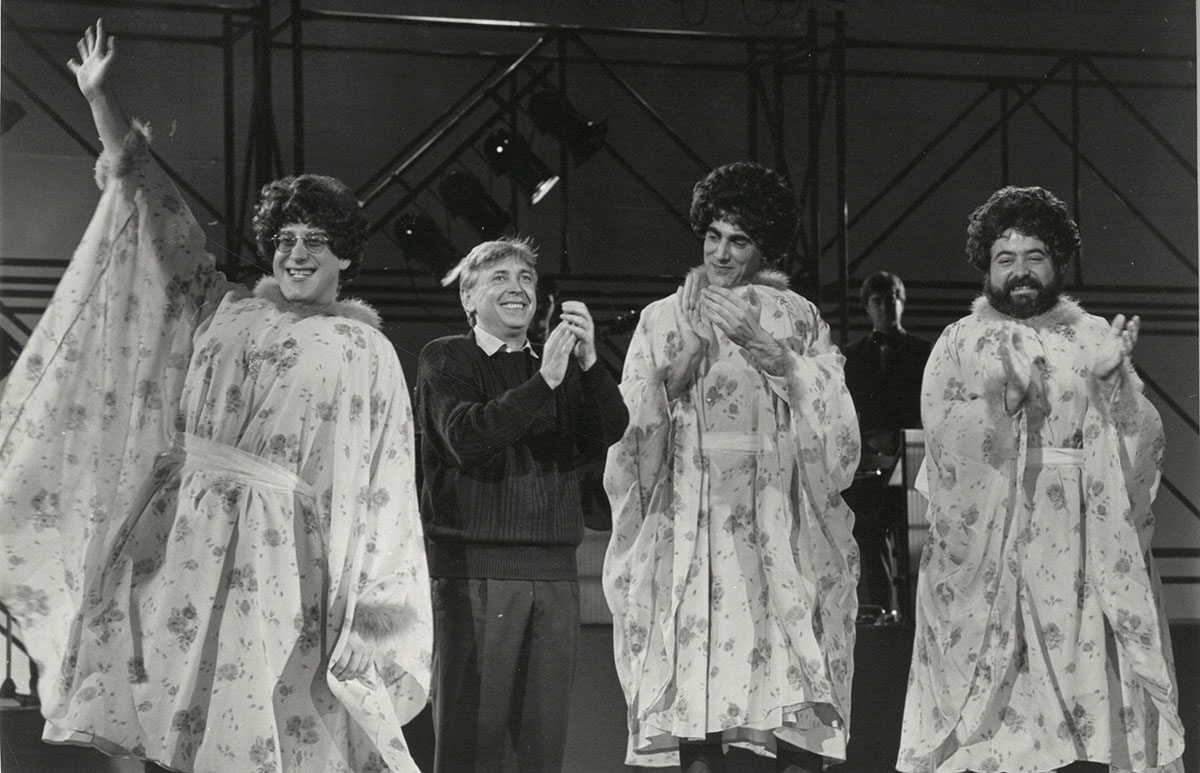
With La Trinca in the program “No passa res” on TV3, Barcelona. 1985. Photo: unknown author.
This LP shows a brief encounter with electronic music. The album Presències i oblit features songs of a markedly intimate nature: Del blanc i el blau, La mar respira calma -a tribute to Salvador Espriu -, Primer parlaré de tu, La dona que vas conèixer, Lector de poesia, Si tu si jo, Al meu cervell que desconec, Per camins d’aigua, Octubre dolç.
For the first time, Raimon performed for almost an entire recital without picking up his guitar at the presentation of his album on 5th, 6th and 7th of March 1987 at the Palau de la Música Catalana in Barcelona.
He sang accompanied by the Barcelona Symphony Orchestra conducted by Albert Argudo in Barcelona’s Cathedral Square in September.
He presented his book of poems by Raimon entitled: D’aquest viure insistent at the Llibreria 3 i 4, Valencia, in November.
It would take Raimon exactly a decade to record a new album, however he was anything but inactive in the meantime. He formed a stable group of chamber accompaniment that he particularly favoured – guitars, double bass, cello, clarinets and accordion – and only sparingly performed in “artistically optimal” conditions. Raimon’s music ranged from: shouted singing, counterpoint melodies, rock, free-jazz, contemporary minimalism, symphonism and chamber music.
In May 1988, Raimon sang at the Teatro Español in Madrid, the Teatro Colón in La Coruña and the Teatro Principal in Santiago de Compostela.
He also performed at the event Raimon Canta Ausias March held at Palau de la Música in Valencia on October 20th and 21st, accompanied by the Symphonic Orchestra of Valencia conducted by Manuel Galduf. He then sang at the UNESCO theatre in Paris on November 4th before returning to the Palau de la Música in Valencia to perform the same programme, Raimon Canta Ausias March, with his group of musicians on the 9th, 10th, 11th, 15th, 16th and 17th November.
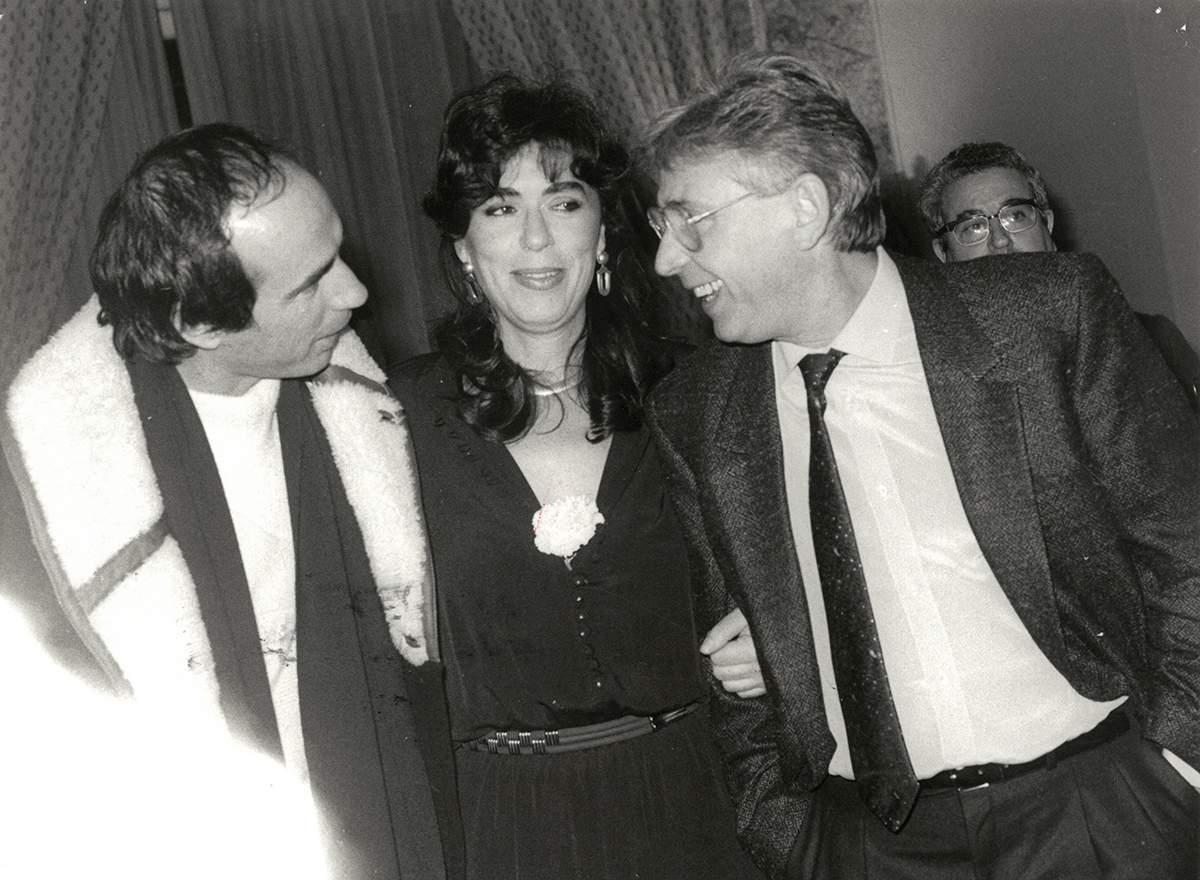
With Maria del Mar Bonet and Lluís Llach at the Hotel Palace in Madrid. 1986. Photo: Botán.
He recorded the same programme, Raimon Canta Ausias March, live with the Barcelona Symphony Orchestra in 1989, at an event organised by the Gremi d’Editors in the Palau de la Música Catalana.
This edited disk was then presented in Madrid on RTVE by Enric Sopena and Manuel Vicent.
1990 | 1999
In April 1991, Raimon began to write a column in the Diari de Barcelona Newspaper. In October he began to take part in a talk show on Catalunya Ràdio; El matí de Josep Cuní and directed a programme called Literal on the Catalan TVE channel in November. This programme about books and literature allowed him to convey his literary knowledge in several languages. He combined these activities with performances.
During the months of April and May 1992, Raimon toured Japan again, visiting Tokyo, Kyoto, Osaka, Hiroshima, Kyoto, Yokohama and Warabi-za.
A great event was held at the Palau Sant Jordi, which was packed to full capacity, on April 23rd 1993. The event was entitled: 30 anys d’Al vent, to celebrate the release of the first song written by Raimon in 1959 while he was studying at the University of Valencia and released in 1963. A number of artists who had shared experiences with him over the years performed on stage: Paco Ibáñez, the Uruguayan Daniel Viglietti, Mikel Laboa from the Basque Country, Luis Cilia from Portugal, the Father of American folk-song Pete Seeger, Joan Manuel Serrat, Ovidi Montllor and Pi de la Serra; these included traditional classical musicians Antoni Ros-Marbà, Josep Pons and Michel Portal, followed by the Japanese group Warabi-za, who received a standing ovation during their performance of Al vent in Japanese; The Sant Jordi Choir conducted by Oriol Martorell and the band Lira Ampostina evoked Raimon’s musical beginnings.
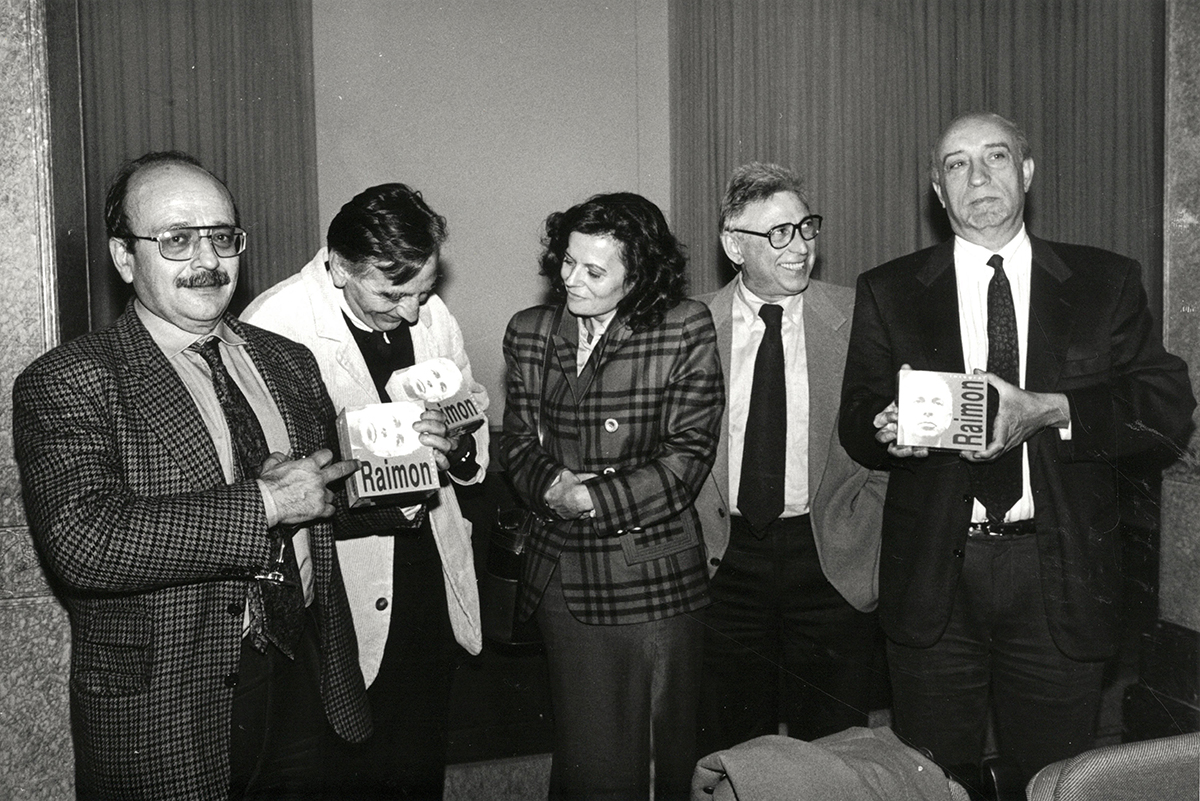
With Manuel Vázquez Montalbán, Carme Riera, Andreu Alfaro and Manuel Vicent at the presentation of the first Integral, Barcelona. 1993. Photo: unknown author.
Raimon sang in the Canary Islands, Las Palmas and La Laguna in September 1993.
He also sang for twelve consecutive days with his group at the L’Espai theatre in Barcelona.
He published Una Nova Integral, now on CD. This project won the Palmarès des Palmarès prize awarded by the Nouvelle Académie Française du Disque, a compilation of 121 songs classified into the following categories: Orígens i dedicatòries, Cançons d’amor i de lluita, Cançons de la roda del temps i d’altres poemes de Salvador Espriu , Ausiàs March i alguns poemes dels segles XV i XVI, Aquest cant vol ser plural i Coincidències, incidències, dissidències i algunes rareses (the latter dedicated to live recordings). Andreu Alfaro, Manuel Vázquez Montalbán, Manuel Vicent and Carme Riera spoke about Raimon’s work at the presentation of the CD held in Barcelona, in November 1993.
A programme about Raimon was broadcasted on Canal 9 in 1994. The programme was divided into two parts: the first, entitled Música i Paraules, was a documentary on the singer’s career, followed by the recital recorded live at the Teatre Principal de Valencia.
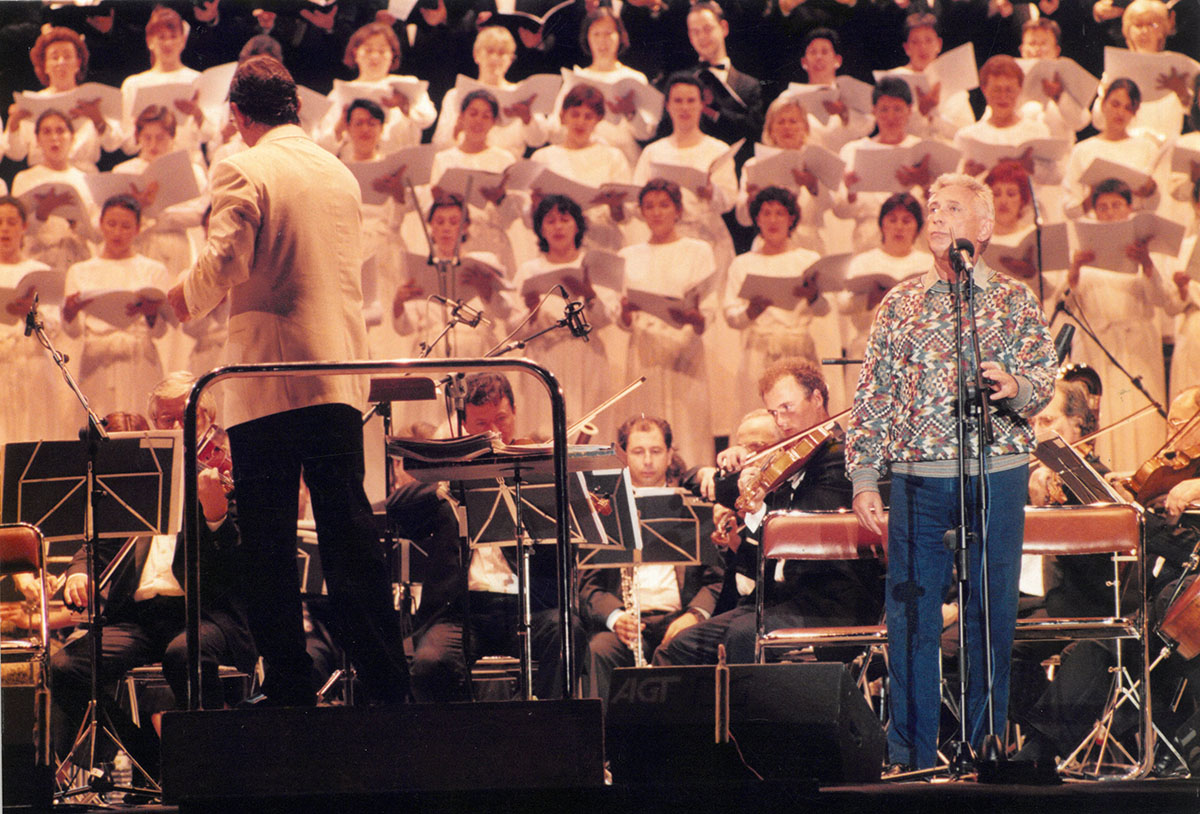
With the Euzkadi Symphony Orchestra (Director: Víctor Pablo Pérez) and the Orfeón Donostiarra (Director: José Antonio Sainz Alfaro) on the centenary of the Orfeón Donostiarra. Anoeta Stadium, Donosti. 1997. Photo: unknown author.
During the months of September and October 1995, Raimon made a tour of twelve recitals at Universities in Canada and the USA, visiting: Toronto (Canada), Bloomington (Indiana), Portland (Oregon), Los Ángeles (California), San Francisco (California), Austin (Texas), Miami (Florida), Gainesville (Florida), Philadelphia (Pennsylvania), New York, Bronx (New York) and Providence (Rhode Island).
At the beginning of 1997, he released an album called Cançons de mai with musical arrangements by Manel Camp. The album included seven new pieces of music by Ausiàs Marc and six of his own songs: Viure junts, Finestra a la badia de Palma, Parlant-me de tu, Oh desig de cançons, Coneixement de l’ombra and Soliloqui solipsista.
Under the title Cançons de mai. Cançons de sempre, Raimon performed in Perpignan, Madrid and Xàtiva – he was refused a theatre in the city of Valencia with excuses -, in Palma, in Andorra and for five days at the Palau de la Música Catalana in Barcelona. He published a CD with live recordings from these recitals called Recitals al Palau. The tour was organised by the newspaper Avui and directed by Vicent Sanchis.
In August, on the occasion of the hundredth anniversary of the Orfeón Donostiarra held in the Anoeta Stadium, Raimon was invited to sing two songs: El País Basc and Veles e vents, accompanied by Euskadi’s Symphonic Orchestra conducted by Víctor Pablo Pérez and the Orfeón Donostiarra conducted by José Antonio Sainz Alfaro.
One of the most talked-about events of the year was the booing he received in September at Plaza de Las Ventas in Madrid, where he performed along with many other singers and actors in an act of homage to Miguel Ángel Blanco (Basque PP councillor assassinated by ETA). There Raimon was jeered by a section of the audience who did not accept him, nor the fact that he sang in “the kind of Catalan spoken in the Valencian Region”, nor that the song chosen was El País Basc, as they claimed it had been banned during Franco’s dictatorship. The event was broadcasted on TVE, and the fact that Raimon was criticised gave it significant coverage. José Sacristán, who took part in the event, defended the singer.
Raimon travelled to Great Britain in October that year, where he sang in Abertawe (Swansea, Wales), Glasgow (Scotland) and Liverpool (England). He then performed in Luxembourg and Lisbon (Portugal) in 1998.
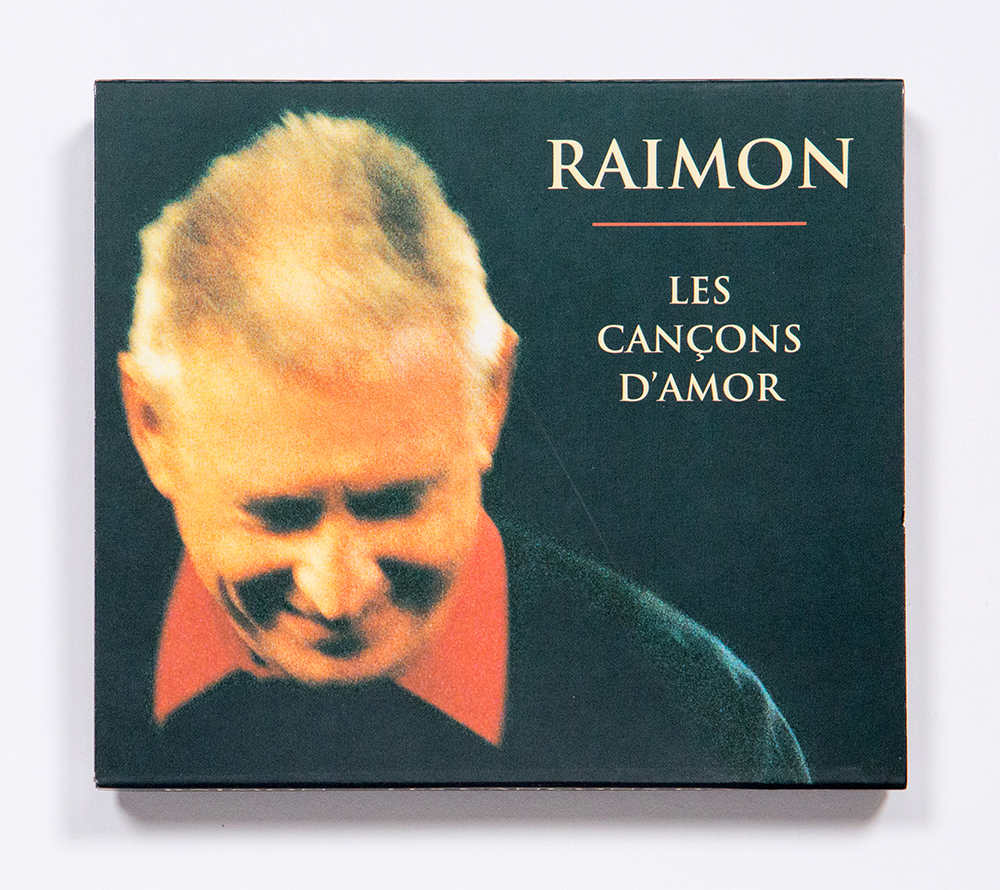
Cover of the album Les cançons d’amor, 1999, Barcelona. Photo: Estudio Federico.
He inaugurated the Teatre Grec Festival in Barcelona from June 29th-31st, 1999, performing Cançons d’amor, cançons de lluita. In December that year, he sang at the First Mil·lenni Festival at the Palau de la Música Catalana in Barcelona.
He published a CD with all his love songs: Les cançons d’amor.
2000 | 2017
At the beginning of the new century, Raimon edited Integral 2000, including new unpublished songs and music from poems by authors of the 15th and 16th centuries: Francí Guerau, Jordi de Sant Jordi, Mossén Estanya, Bernat Metge and Jaume Roig (the tragic fragment of the Hostalera de París found in the Espill). Integral 2000 also brought together the only two songs by others that Raimon had sung in public and recorded: Se’n va anar (Josep M. Andreu and León Borrell) and Amanda (Víctor Jara).
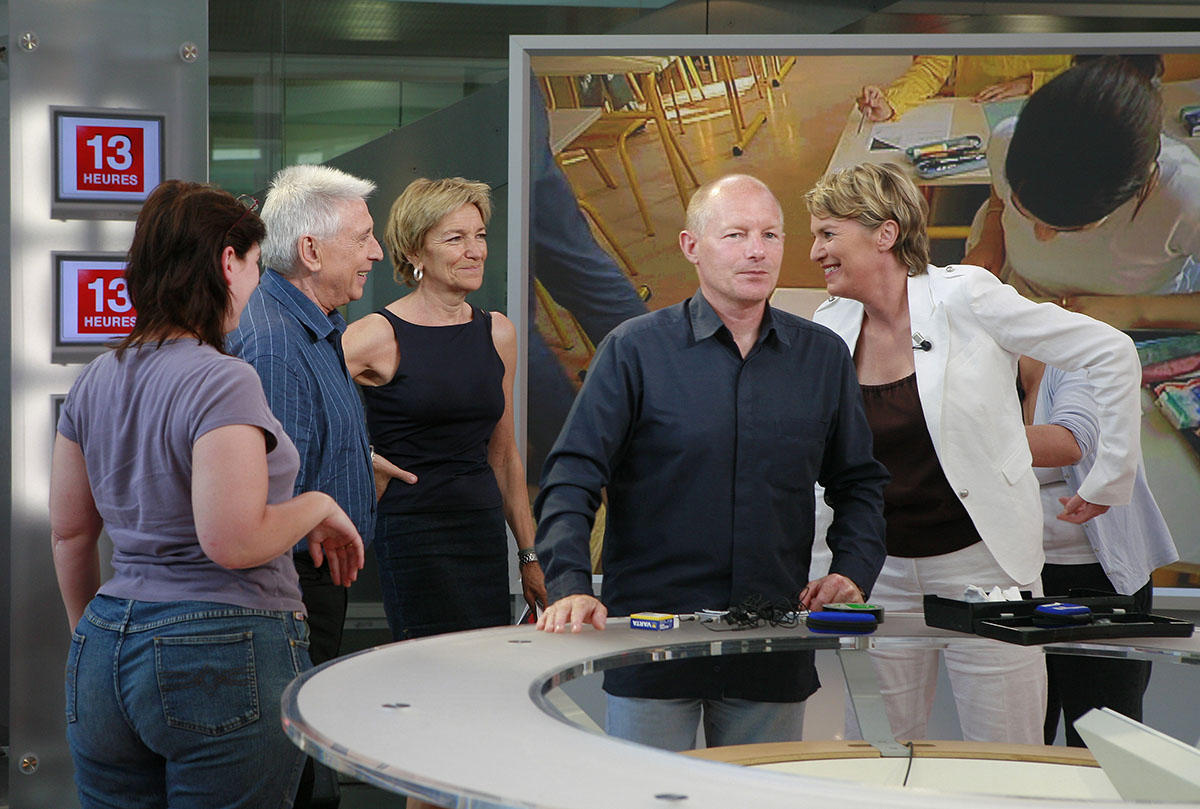
French television program. ORTF Telediari “13 heures”. Paris. 2006. Photo: Mordzinski.
Raimon presented Integral at the Palau de la Música Catalana, Barcelona, on the 17th, 18th, 19th, 25th and 26th November as well as the 1st and 2nd December.
He was made an honorary member of the Catalan Language Writers Association in recognition of his career as a writer and for his contribution to the worldwide dissemination of classic poets of Catalan literature.
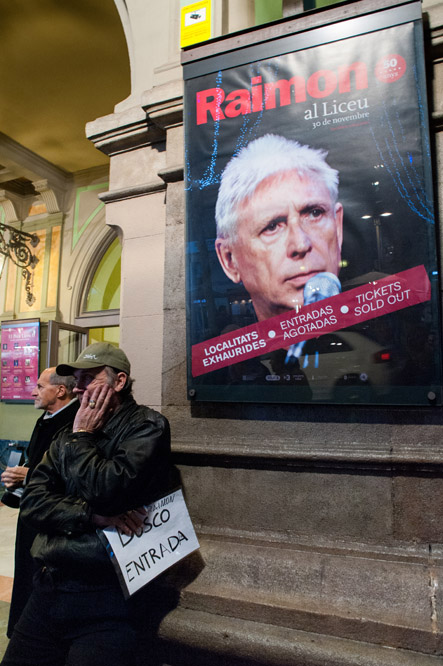
Atmosphere at the Teatro Liceo in Barcelona. 2012. Photo: Bofill.
Raimon sang in Toledo in January 2002; at the Teatro Albéniz in Madrid on 21st, 22nd and 23rd June; at the Almagro Festival on the 12th and 13th July: “Clásicos valencianos de la literatura catalana. Siglos XV y XVI” and presented, Clàssics i no at Barcelona’s Teatre Nacional de Catalunya on 17th, 18th, 19th and 20th October.
He performed in Sarajevo and Madrid in February 2003.
He presented Raimon canta Espriu at the Teatre Lliure in Barcelona from the 29th May the the 1st June.
In February 2004, Raimon sang Raimon canta Espriu again at the Barcelona Auditorium.
In October 2005, he sang at the Teatro Mercadante in Naples, and at the University of Luxembourg in November of the same year.
He sang again at Catalunya’s National Theatre in January and February 2006, performing eight recitals in two batches of four with the title “Quatre recitals diferents”, containing a different repertoire each day.
Raimon sang at the Hermitage Theatre in Moscow on March 13th.
He then returned to sing for the fourth time at the Olympia in Paris in June. The reason: to celebrate 40 years since his first performance at the Olympia in June 1966. Picap released two CD’s with his first recital and this last one, both recorded live.
Raimon was awarded the Honorary Prize of the Spanish Academy of Music on March 21st, 2007.
The Universidad Complutense invited him to sing at the Ramon y Cajal Amphitheatre of the Faculty of Medicine in Madrid on May 22nd 2008, to commemorate 40 years since his first performance in May 1968.
He then performed an anthological recital for the closing ceremony of the open day at Castell de Monjuïc, reclaimed for Barcelona’s memorial heritage, on June 15th.
A recital was held at the Universitat Politècnica in Valencia on May 8th, 2009, to celebrate the 50th anniversary since the composition of the song Al vent. This was accompanied by the publication of a Catalan-Spanish-English catalogue and an extensive exhibition on Raimon’s life and work. A large sculpture by Andreu Alfaro was placed at the entrance of the exhibition, entitled: “Raimon. La veu d’un poble.
Raimon was awarded a medal from the Universitat de Valencia in 2010, and a recital was organised to take place at the Teatre Olympia in Valencia on February 23rd, after which he sang at l’Auditori in Barcelona on March 25th and at the Grand Anphithéâtre del École de Musicologie del Université de la Sorbonne in Paris on April 14th. He then returned to sing in Xàtiva, where he had not been able to perform for years. Faced with the indifference of the town council, he rented the Gran Teatre de Xàtiva to offer his fellow citizens three anthological recitals full of feeling and emotion. TV3 broadcasted this recital in two programmes.
At the start of 2011, Raimon was awarded an honorary doctorate by the Universitat d’Alacant. He released a CD entitled Rellotge d’emocions and presented it when singing at Teatro Madrid on February 18th; at Teatre Tivoli in Barcelona on 18th, 19th and 20th March, and at the Gran Teatre Del Liceu on 1st October. Rellotge d’emocions is a CD with ten songs and musical arrangements by Manel Camp: A l’estiu quan són les 9, Si miraves l’aigua, Punxa de temps, Mentre s’acosta la nit, Diré del vell foc i de l’aigua (based on a poem by Salvador Espriu ), Bagdad’91 (la guerra en directe), He passejat per València sol, Terra negra, Cançó d’un cor que crema, Barcelona ’71.
Raimon excelled with delicate narratives – some of which were situationist, although this was an uncommon register in his work – and a reflection on the passage of time.
The Department of Culture of the Government of Catalonia commemorated the 50th anniversary of Raimon’s first recital in Barcelona by holding a series of events from November 2012 to January 2013; an exhibition was held at Arts Santa Mònica in Barcelona, entitled “Raimon. Al vent del món” to showcase both the most intimate and public aspects of Raimon’s biography and bring together works of art linked to his career, by artists such as Joan Miró, Antoni Tàpies, Joan Pere Viladecans, Guinovart, Artur Heras, l’Equip Crònica, Andreu Alfaro and Vicente Rojo, among others; album covers by Oriol Maspons, Colita, Ros Ribas, Jordi Fornas and Leopoldo Pomés. The exhibition also included a collection of original posters from different periods and countries, as well as records, LPs, CDs, EPs and complete editions, filmed interviews and audiovisual projections of his recitals. It was complete with the artist’s literary work in prose, letters, texts and articles that Raimon had written in Spanish for the Destino magazine (1964) and in Catalan for the Diari de Barcelona (1991) together with all the annotated and classified documents that passed through the filter of Franco’s censorship.
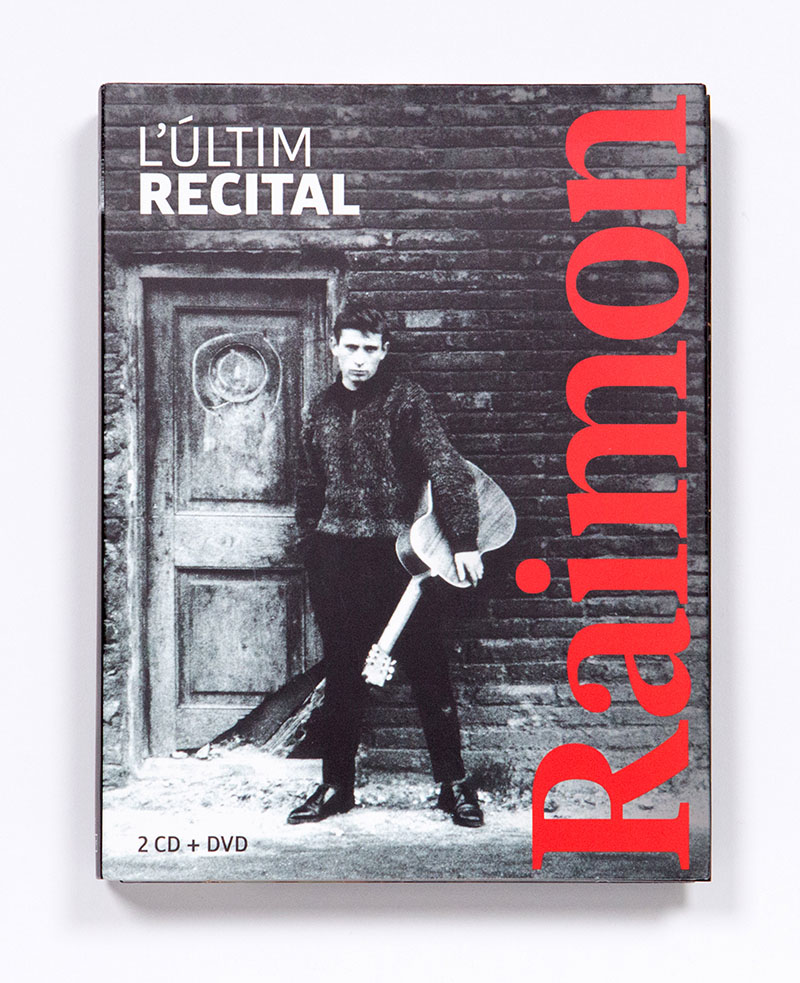
Cover of the album El último Recital, Directo, Palau de la Música, 2018, Barcelona. Photo: Federico Studio.
This event also included a presentation by the Filmoteca de Catalunya, entitled “Raimon imatges i so”, and recitals at five European universities: at the Reutersaal of the Humboldt Universität in Berlin, at the Théâtre Robert Krieps of the Abbaye de Neümester in Luxembourg, at the Great Hall of King’s College in London, at the Grand Amphithéâtre de l’École de Musicologie of the Université de la Sorbonne in Paris and at the Teatro Il Vascello of the Universitá La Sapienza in Rome. These five performances held at five European Universities are proof of the interest in Raimon’s artistic creation, his songs and his musical renditions based on medieval and contemporary poets. The recitals were preceded by talks and colloquiums that placed the singer in his socio-political and cultural context. The tour culminated with a concert held at the Gran Teatre del Liceu in Barcelona on November 30th, where Raimon gave a generous review of his work, of which Sony has released two CDs to document and celebrate this moment that constituted a peak in the singer’s artistic career.
In 2012, Raimon was awarded the Medalla d’Or by Barcelona’s City Council.
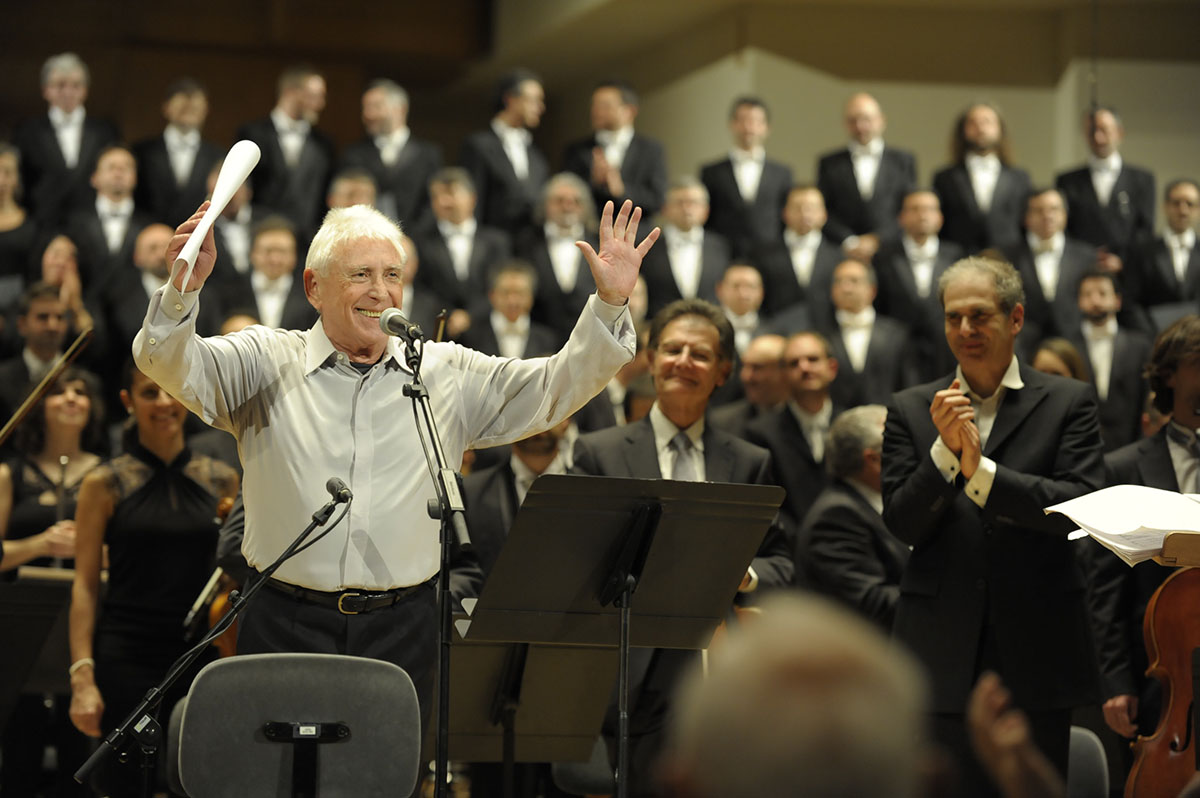
Palau de la Música de València Symphony Orchestra conducted by Yaron Traub and Choir conducted by Francesc Perales. 2016. Photo: Revelarte.
On November 9th, 2013, Raimon returned to sing again at the Auditori of Barcelona, before attending the Círculo de Bellas Artes in Madrid on the 21th and giving a magnificent performance at the Auditori de Palma on the 13th.
En mayo del 2014 los días 8, 9, 10 y 11 vuelve al Palau de la Música Catalana de Barcelona. Aquel mismo año fue distinguido con la Medalla de Oro del Círculo de Bellas Artes de Madrid y con el 46é Premi d’Honor de les Lletres Catalanes, la primera vez que un cantante recibía un premio literario de esta magnitud.
He returned to perform at the Palau de la Música Catalana in Barcelona on the 8th, 9th, 10th and 11th May, 2014. That same year, he was awarded the Gold Medal by Madrid’s Círculo de Bellas Artes along with the 46é Premi d’Honor de les Lletres Catalanes, the first time a singer received a literary award of this magnitude.
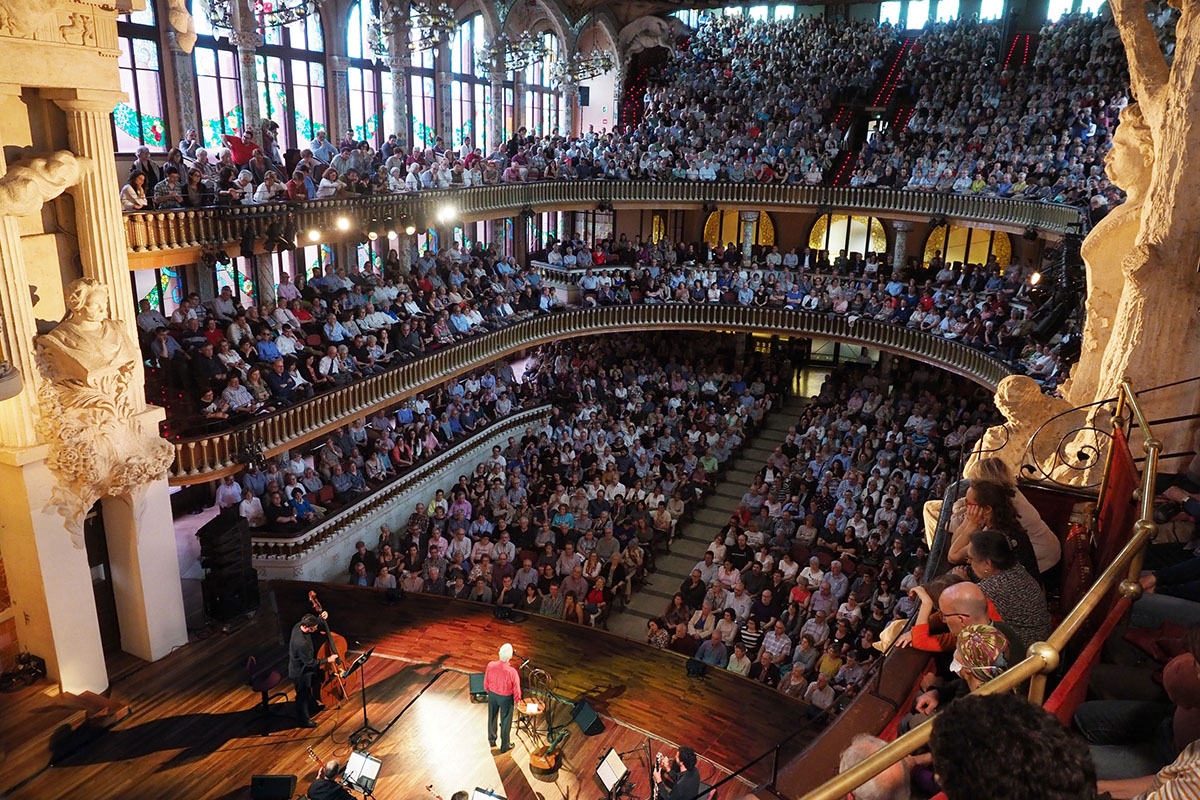
Palau de la Música Catalana de Barcelona “L’últim recital”. 2017. Photo: Bofill.
In November 2015, Raimon performed two recitals in Xàtiva. The recitals were organised by the new town council, which had by then put an end to many years of PP government. Before the event, Xàtiva’s City Council awarded Raimon the title of Fill Predilecte and the Medalla de la Ciutat (City Medal). In October, he was awarded a High Distinction and the Gran Creu de l’Ordre de Jaume I El Conqueridor by the Generalitat Valenciana
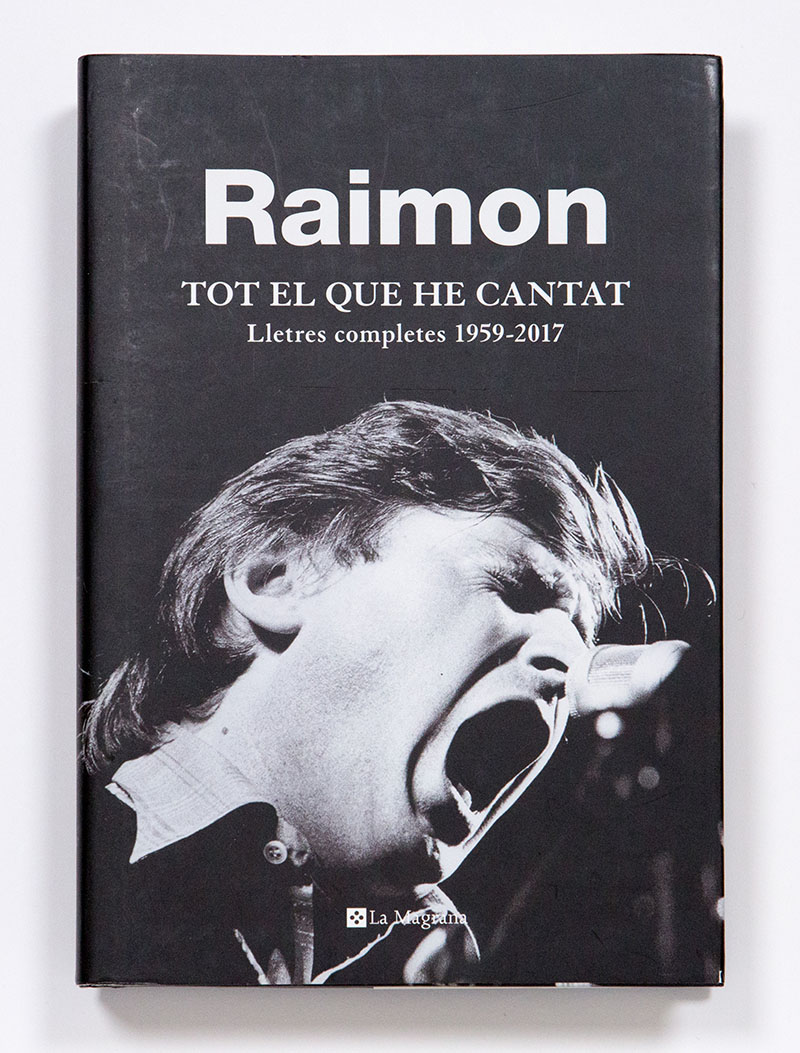
Book cover Todo lo que he cantado, Editorial RBA, 2017, Barcelona. Photo: Federico Studio.
Raimon performed at the Auditori of Barcelona on the 3rd and 4th December.
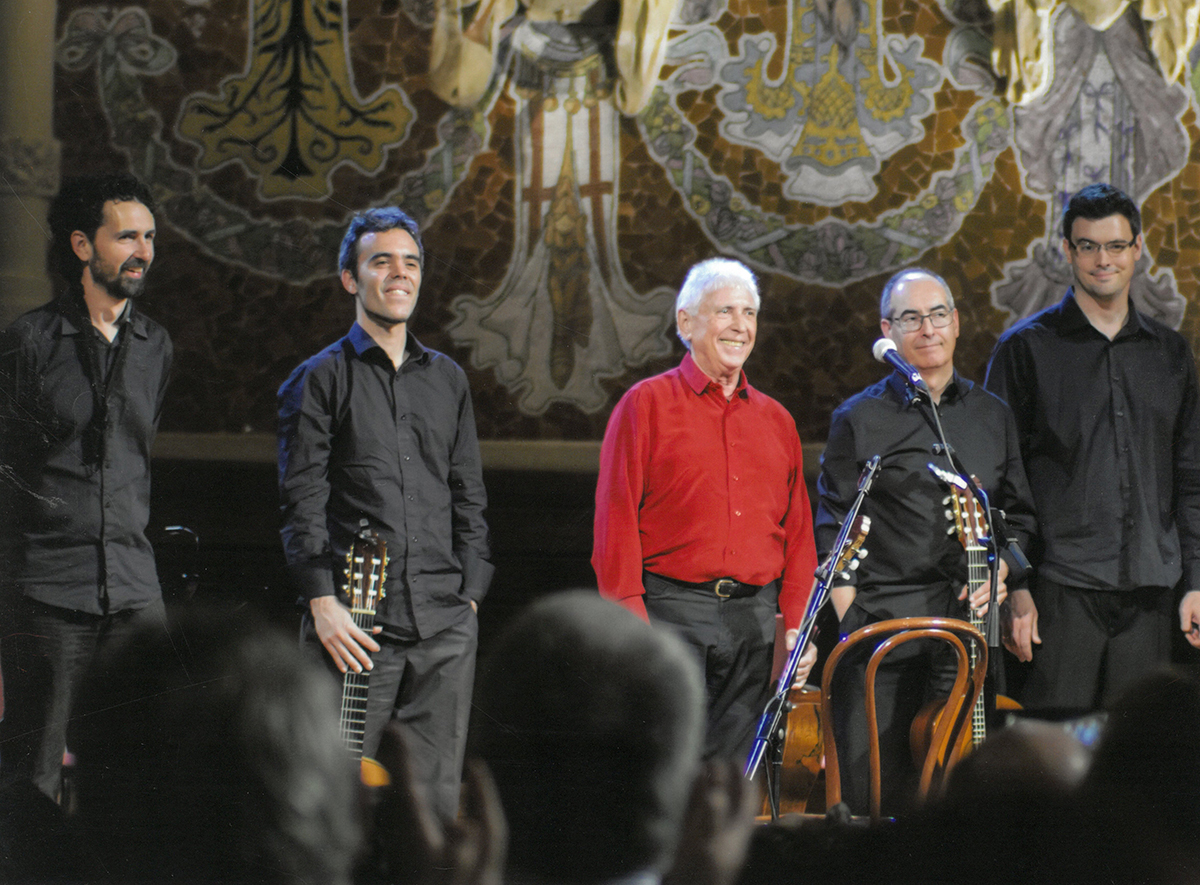
With Pau Doménech, Joan Urpinell, Miquel Blasco and Fernando Serena, “12 Farewell Recital”, Palau de la Música Catalana, May 2017, Barcelona. Photo: Bofill.
In 2016, he returned to perform in the Valencian Region. The Generalitat Valenciana organised a tour of twenty recitals called Raimon a casa, held at the Teatre Principal in Castelló, Elda and València on the 15th, 16th and 17th of April, and at the following other locations: Ontinyent, Alzira, Sagunt, Alcoi, Buñol, el Campello, Morella, Gandia, Dénia, Castelló, l’Eliana, Benicarló, Elx, la Vall d’Uixó, Alacant.
The tour came to a close in December, with a recital held at the Palau de la Música in Valencia. Raimon performed accompanied by the Orchestra of Valencia conducted by Yaron Raub and the Generalitat Valenciana choir conducted by Francisco Perales.
«12 recitals de comiat»
There remains a pack of these recitals, entitled Raimon. L’últim recital, made up of two CD’s of the live performance of the last of the twelve songs, a DVD and a book published by Picap in 2018 with the original lyrics translated into Spanish, French and English.
Annalisa, Raimon’s loyal supporter
Raimon and Annalisa were married two years after they first met, on August 22nd 1966, in Annalisa’s hometown, Ostia Antica, a town located near Rome where they also went on to live.
A graduate in law, Annalisa Corti worked alongside Raimon on a whole range of matters related to the singer’s activity. Despite having had a seemingly imperceptible outcome, her efforts played a vital role for the success of their joint decisions.
From 1967 onward, Raimon and Annalisa would share all decisions on which performances were acceptable.
Throughout the dictatorship period, Annalisa was in charge of providing recital organizers with the lyrics of the songs to be performed so that they could be approved by the censors and permission could be granted to use the venue where the recital was to be held. Annalisa took care of the arrangements personally when performances were held in large cities. She also organized international meetings in France, Italy, Europe in general, the United States and Japan.
Annalisa drafted and signed contracts for the performances, managed the logistics of the trips, the hiring and fees of the musicians, publicity and event posters, in addition to organizing the press conferences, interviews and photo shootings that Raimon decided to accept.
She was in charge of commercial relations with record companies and literary publishers as well as a range of other entities, such as the Sociedad General de Autores (SGAE) and the Sociedad de Artistas e Intérpretes (AIE). She took care of correspondence and filing records.
Raimon dedicated endearing love songs to his wife.
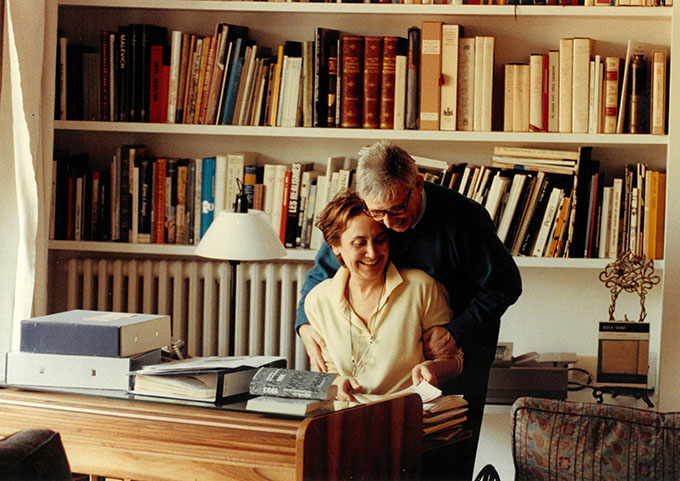
“Their love was at the fore at each and every stage of their journey, and they constantly renewed the romantic thrill of the first days: Raimon never let the flame die, he would accompany Annalisa to the airport when she traveled to “her country Italy”, and wouldn’t lose sight of her until waving farewell after she had passed all the checkpoints. Theirs is an unusual story collected in love songs that were all written to the same woman”.
Antoni Batista
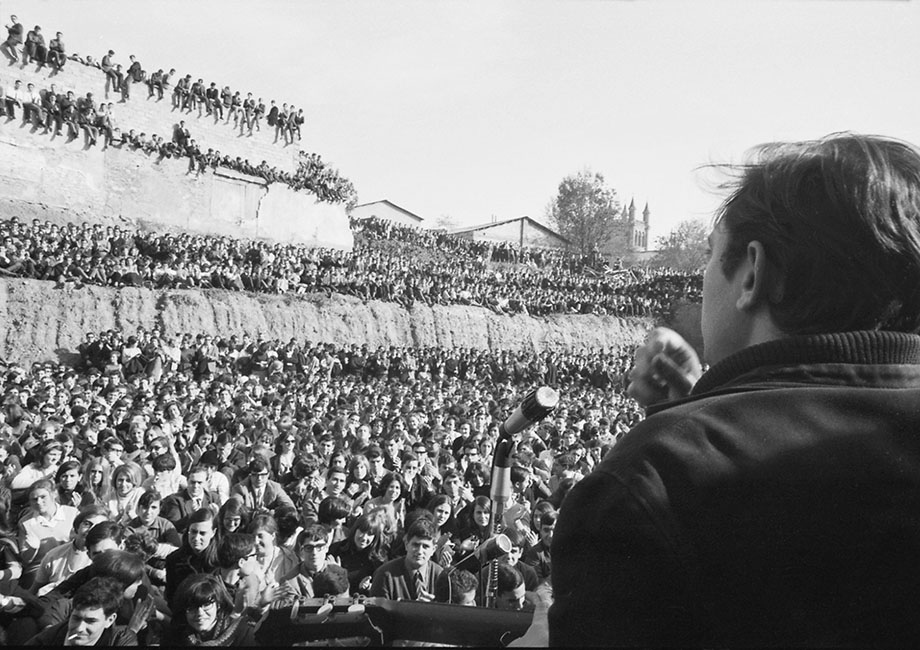
Jo vinc d’un silenci
antic i molt llarg
de gent que va alçant-se
des del fons dels segles
de gent que anomenen
classes subalternes,
jo vinc d’un silenci
antic i molt llarg.
Jo vinc d’un silenci, 1975.
